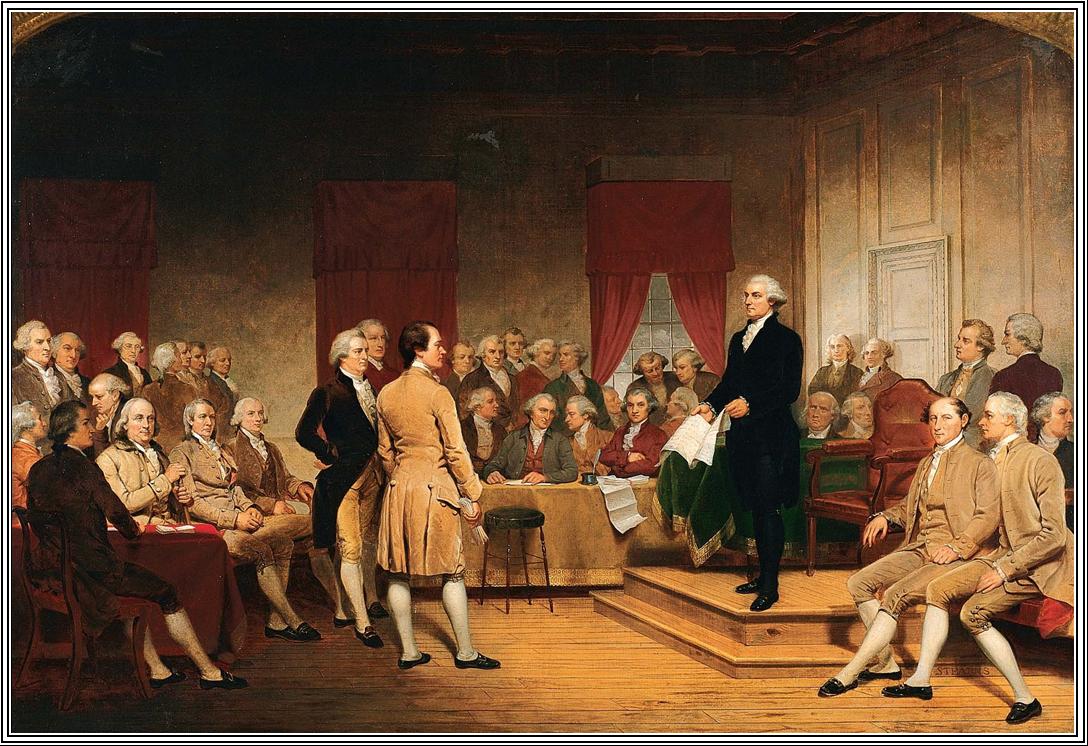Chapter One
The Kingdom of Liberty

A History of the United States
A History of the United States
"Unlike the centuries-old absolute monarchies of Europe, which ruled for power and control, the American monarchy ruled for nearly the exact opposite: liberty and independence. Since Henry the First to George the Second, we have been dearly blessed with a successful experiment, a Kingdom of Liberty." - U.S. President Lester Pearson (July 4, 1964).
Chapter One - A Disunited Union
The Siege of Yorktown was the final nail in the coffin for any British hopes of holding onto their American colonies. American, French, and Prussian Armies evicted the British from Yorktown and forced Great Britain into peace negotiations with their former subjects and their European allies.
As the ink dried on the Treaty of Paris, one of America's heroes met a sudden demise. General George Washington, one of the most unifying figures of the American revolution, would not live long enough to see the product of his leadership. On the evening of March 21, 1784, General Washington was riding his horse from Arlington to Mount Vernon. An earlier storm had knocked trees and debris into the roads. At dusk, Washington and his horse failed to see a downed tree that was spanning the road. His horse tripped and the general was launched from his saddle to the ground. Washington struck his head and broke his neck, rendering him unconscious. A mail courier found General Washington an hour after the accident and recognized him almost immediately. By that time, however, it was too late. The United States had lost her father.
General George Washington, the Father of the United States (1732-1784)
The Congress of the Confederation unanimously declared March 26, 1784 a day of mourning for General George Washington.
Two years after the death of George Washington, the United States appeared to be coming apart at the seams. The loose Articles of Confederation caused states to quarrel and impose trade restrictions on each other. The federal government of the United States lacked almost any power to stop the fragmentation. For example, Philadelphia could not raise a standing army to intervene in such problems. The power to raise a military was through the states, which were struggling to survive. This lack of authority would culminate in the infamous Shays' Rebellion.
Massachusetts Governor James Bowdoin, the successor to John Hancock, governed as the exact opposite of his predecessor. While Hancock barely enforced tax collection, Bowdoin imposed a harsh fiscal policy on Massachusetts. Taxes that had not been paid in years were recalled by Bowdoin. The dreary economic situation in Massachusetts began to deteriorate further due to the taxes and the commonwealth’s staggering debt. Along with a bad fiscal situation, Boston began to gain a reputation as a hub of political corruption and malpractice, with Bowdoin at the center of it. As expected, many of Massachusetts’ residents were angered by Governor Bowdoin’s policies. For many, it brought back memories of King George and his harsh tax policies across the colonies.
Large protests had taken place across Massachusetts since late August of 1786. Protesters across the state, calling themselves Regulators, managed to shut down the county court to seek relief from “burdensome” and depriving judicial proceedings. Governor Bowdoin condemned the protesters as “mobs” and called on the militia to quell the protests. As protests continued, the government would turn increasingly harsh and impatient with the Regulators, with Senate President Samuel Adams threatening to punish rebels by execution.
With tensions running high and a huge rift between the state and its people, it appeared a second revolution would be coming to North America.
The Siege of Springfield
On January 26th, rebel forces led by Daniel Shays, Luke Day, and Eli Parsons launched an attack on the Springfield Armory. The militia present at Springfield, commanded by General William Shepard, were shockingly overrun by the rebel forces, being significantly outnumbered. Shepard withdrew his remaining forces and moved east. As the armory fell to the Regulators, Governor Bowdoin pleaded the Congress of the Confederation to supply an army for him, but per the Articles of Confederation, this could not be done. The Regulator militias moved east, raiding shops for food and clothes along the way. General Benjamin Lincoln, who had been headquartered at Worcester, moved south and intercepted the Regulators at Douglas, where he oversaw their defeat and the capture of Shays, Day, and Parsons. Many of the rebels scattered from the battle and thus avoided capture by Lincoln’s men. In total, the rebellion cost half a thousand lives on both sides.
While ultimately a failure, Shays’ Rebellion completely changed how all Americans felt about governing. It was clear that the decentralized Articles of Confederation was ineffective at governing and keeping order. State governments began to fear that rebellions inspired by Daniel Shays could begin in their own backyards and lead to their demise. Patriots who fought for independence feared that the Union would continue to crumble and potentially lead to British rule once again. Nearly every American agreed on one notion: a new constitution.